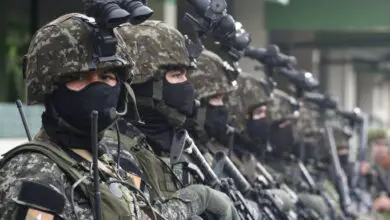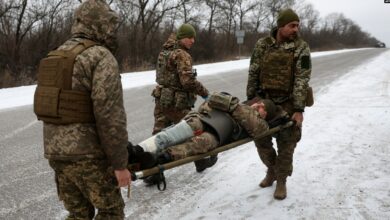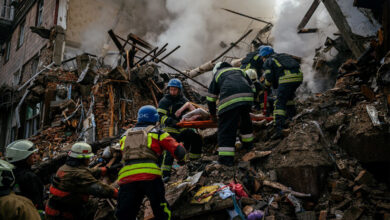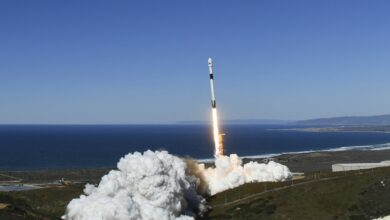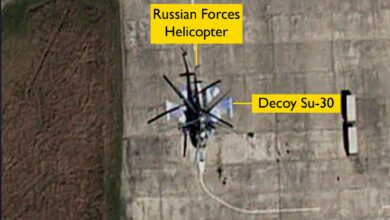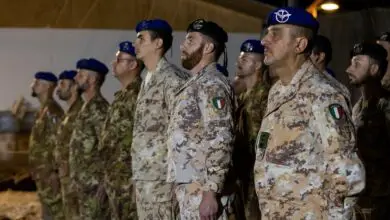
Current and future adversaries, primarily Russia and China, continue to threaten American leadership and security globally while intimidating their neighbors. To counter their efforts, America must refocus how it structures its conventional forces and move away from previous concepts.
America should embrace a concept of two simultaneous wars: a Land War in Europe and a Maritime War in the Pacific. Structuring the Joint Force this way, enabling it with updated technologies, and adjusting how it handles Anti-Access Area Denial and “gray zone” environments will ensure its success for decades to come.
Great Power Competition
Despite two philosophically opposed administrations, the threat from the Great Power Competition remains America’s number one security priority as described in the 2017 National Security Strategy, the 2018 National Defense Strategy, and the 2021 Interim National Security Strategic Guidance.
Russia continues to pursue efforts to undermine NATO unity and resolve by exploiting weak European institutions and governments. It has shown its willingness for armed conflict in Georgia and Ukraine and intimidates its neighbors through periodic shows of force with forward-deployed troops, cyber-attacks, and covert operations.

China continues to use economic inducements, penalties, and military threats to coerce compliance with its political and security agenda. It has made clear that it will stop at nothing short of total control of the South and East China Seas as well as reacquiring sovereignty over Taiwan and that it is willing to use military force to achieve these objectives.
North Korea is rapidly accelerating its cyber, nuclear, and ballistic missile programs as it looks for means to ensure its security. While there has been a thawing in the relationship between the two Koreas, the peninsula is still a hotbed of potential for conflict. Their continued provocations serve to further America’s security partnerships; however, they also risk nuclear proliferation in the region.
Iran aggressively pursues nuclear enrichment, likely for weapons production. It threatens its neighbors in the Arabian Gulf region, and provides massive support to state-sponsored terror organizations.
As the United States removes most combat forces from the CENTCOM area of responsibility and pivots towards Great Power Competition, this may likely embolden Iran to increase its hostile actions to reassert its global presence and counter Israel.
These competitions are not passing trends and require sustained national attention and commitment. America’s adversaries exploit its binary view of “war” and “peace” by exploiting the gray zone to challenge US leadership and resolve.
As a relatively young nation, the US is accustomed to its Eagle either pointing towards the arrows or the olive branch. This binary view on global conflict is not consistent with the ancient national identities of these “Axis of Evil” countries, most of whom are comfortable with decades, if not centuries, of lasting gray zone conflict, a concept foreign to the United States.
Calculation of Risk: Most Likely vs. Most Dangerous
A 20th-century war of attrition is unlikely against Russia or China. However, as the most dangerous scenario it must not be ruled out. A large-scale conventional war against either nation must form the basis for Conventional Force structure. For the possibility of conflict less than all-out war against either nation, America must develop and exploit technology to be at parity with Russia and China in the gray zone.
Additionally, America must also maintain a potent response to a North Korean invasion or assault on South Korea or Japan to maintain deterrence and foster partner relationships in the Western Pacific.
Similarly, conflict with Iran is tangible, and uncertainty of international political will may require unilateral action to dissuade Iranian aggression and, if required, eliminate Iran’s nuclear capability.

Finally, Washington must always be prepared to provide military support for unforeseen conflicts, similar to its response in Libya in 2010. America should not look to make these enduring or resource-intensive endeavors as we responsibly employ the military and elevate diplomacy as the primary instrument of power.
New Focus
Historical defense policy has been centered on the concept of either being able to fight One Major Conflict + Two Smaller Conflicts or Two Major Regional Conflicts (2MRC) simultaneously. This planning suffered from being overly generic and often duplicating efforts. It is also largely based on fighting either a Westphalian-type war, as in WWI and WWII, or containing Communist expansion throughout the world.
The threats facing America are well defined and unlikely to change for the next two to three decades, making this generic approach no longer sufficient. Therefore, a new concept should be adopted: One Major Land War (Russia) + One Major Maritime War (China).
Constructing the force with this approach will ensure it is designed to defeat the intended adversary while reducing redundancy and recapitalizing defense dollars. This is not a relabeling of the 2MRC concept but a complete overhaul.
In Europe, the Army and Air Force would be the lead services fighting, supported as necessary by the Navy, Marine Corps, and Space Force. In the Pacific, the Navy would be the lead service, supported by the Army, Air Force, Marine Corps, and Space Force.
Shaping the Joint Force this way ensures that inter-service rivalries are minimized by aligning goals and defining roles and responsibilities. It also guarantees all services can meet primary and secondary objectives.
Budget restraints will prevent a dedicated contingency force, however, the services should be permitted to use their dedicated Land or Maritime forces with the understanding that Contingency Operations would be suspended if one of the two worst-case scenarios unfolded.
Additionally, not having a dedicated contingency force requires America to make the tough choices and insulate against a re-occurrence of the 2003 Iraq war while allowing military action similar to Afghanistan.
Conventional Force Policy Recommendations
First and foremost, our military forces must maintain the concept of overmatch. Using the Iraq war as a basis, land forces in Europe, outfitted with emerging technologies, must meet the same overmatch criteria that proved effective in 1991 and 2003. Force levels should not be based on peacetime combatant commander requirements.
How many brigades is enough? The number required to defeat Russian Land forces with the assistance of NATO allies while still being able to provide the requisite support to the maritime war in the Pacific is the right answer in this scenario. Similarly, aircraft carrier numbers should be the number necessary to defeat China in a naval war while providing the requisite support to the Land war in Europe.
The primary goal of the American military is homeland defense. That means continuing the legacy of fighting wars overseas. Logistical challenges of a rapid buildup delay the ability to fight tomorrow. This translates to a large forward deployed force.
America should seek to forward deploy large Army and Air Force footprints in Europe that are ready to respond quickly. This will strengthen NATO resolve and provide the credible deterrent critical to preventing hostile acts from Russia. In the Pacific, the Navy should maintain the preponderance of its forces focused on ensuring a quick and potent response force is always available to protect the Taiwan Strait or rapidly crush a belligerent North Korea.

Washington should no longer provide stability operations or occupation forces to contingencies operations. The last two decades have shown how this decimated the Joint Force and dulled its warfighting ability.
The Department of Defense, along with the Department of State, should look to create a small, reserve gendarmerie-type force that could be used for this kind of employment. This will ensure that the forces tasked with fighting and winning the nation’s wars can always do so without getting bogged down by lower level conflicts. This will also provide options for follow-on strategies that were severely lacking in Iraq and Afghanistan.
US active-duty military forces are responsible for all initial action in wartime. However, an active force large enough to sustain a long war against Russia or China is cost-prohibitive. Active-duty forces should be restructured based on the time to reconstitute, train, and deploy reserve forces. This was a hindrance to America’s full entry into WWII and remains the country’s chief obstacle to mobilizing for its next global conflict.
A war against Russia or China is more than the active force can or should be expected to handle and, in reality, are emergencies that would require national mobilization. Reserve forces (both active and inactive) should be sized to account for these protracted scenarios.
Reserve forces should be used to perform tasks that require less training, while active forces focus on the higher order of warfare.
Options such as moving Infantry Brigade Combat Teams (BCTs) to the National Guard or Reserves should be explored while expanding Armored BCTs and Stryker BCTs in the active force.
The establishment of CYBERCOM has done much to increase America’s information warfare capability, but it is time for the next step to fully exploit this still under-exploited capability. The next war will require that information warfare is fully integrated into combined-arms warfare.
The Department of Defense should establish component-level cyber commands in EUCOM and PACOM that bring command and control of assigned or apportioned cyber forces that can fully integrate into the fight at all levels of warfare.
Technological Investments
No matter how large force levels are or how well trained they are, defense technology continues to grow, and America cannot afford to lose its advantage. The force must be enabled with the world’s best technology to not only win but minimize impact on human life by looking to invest in the following technologies:
Advanced Missile Technology
The next war will utilize hypersonic anti-ship cruise missiles and land-attack missiles, as well as intra-theater conventional ballistic missiles to attack adversaries at long range. Russia and China have focused on this for years, and a missile gap is growing. This hinders the United States’ ability to meet China in a full-scale maritime war.

Stand-Off Capability
Increasing the range of artillery and naval guns with new precision munitions will extend force projection capability while providing the necessary protection for allied forces.
Precision, Navigation, and Timing
America is overly reliant on GPS, a decades-old system easily denied at least locally and likely globally shortly. Without advanced Precision, Navigation, and Timing equipment, forces will not be able to get to the fight or bring the desired effects to the battle once there.
Advanced Communications
Similar to GPS, America’s reliance on network-centric warfare must not be denied due to dated equipment and technology.
Additionally, Russia and China’s development of their electronic warfare capabilities threaten to completely cut off America’s command and control in an overseas war, a threat that would require area commanders to operate independent of their combatant commanders. This is a warfighting tactic US unit-level commanders are drastically underprepared for, except in isolated communities such as Special Operations Forces and undersea warfare.
Undersea Warfare
America maintains the best undersea forces in the world. However, inferior adversaries may look to overwhelm them with sheer numbers. Current submarines are too expensive and unable to patrol sufficient water space to maintain sea control. Cheap wide-area technologies should be developed to act as a force multiplier for current capabilities.
Stealth Technology
America’s dominance in stealth technology is unchallenged, but air defense technology is not far behind, and America must keep at least a small advantage.
Challenges During Conflict Less Than War
The word “peacetime” is often troublesome and does a poor job explaining the current environment. In reality, against both Russia and China as well as Iran and North Korea, there is always some level of some conflict less than the threshold of war. This will continue, and America must find ways to confront these challenges.
The first major front is in Anti-Access Area Denial (A2AD). As America looks to confront A2AD, there are several investments it should make. This is also true for the second concern, which is the gray zone that countries such as Russia and China continue to operate in. Importantly, neither of these are wartime problems as their means can be eliminated with force.
The following recommendations address these concerns. The first two are technological and acquisition-based, while the last two reflect changes to operational postures.
Smaller Ships
Aircraft carriers and large-deck amphibious ships are too expensive and vital to the Joint Force to risk losing. A fleet of smaller, faster, and cheaper vessels would lower the risk of a total loss and enable US commanders to provide better options to counter Chinese aggression inside the first island chain.
Additionally, China’s developments of hypersonic anti-ship cruise and ballistic missiles is quickly making the carrier strike group an irrelevant force structure in the South and East China Seas.
Missile Defense
Increased defenses against anti-ship cruise and ballistic missiles would also enable better options. Current missile defense has crippled potent offensive weapons on destroyers and cruisers and minimized their ability to maintain an effective presence at sea.

Cyber Capabilities
To combat these threats, Washington should increase cyber capability and give additional authorities to CYBERCOM.
America’s adversaries have no qualms about attacking American networks, both commercial and government, and America cannot look only for moral high ground as the path forward. Attacks need to be met with solid responses, and opportunities to diminish gray area or A2AD operations should be explored.
Taking Risks
Finally, we cannot refuse to operate in A2AD areas. No gain comes without risk and sometimes loss. America should look for opportunities to take risks without incurring significant loss to demonstrate its resolve.
Conclusion
To meet America’s challenges head-on, some fundamental aspects of how war is planned must be changed. A renewed focus on Joint Force Structure based on current threats is overdue, and the methods for doing so are too generic. The bare minimum is a force that can meet the discussed challenges over the next few decades with the best technology sustainable for the enduring effort.
Undoubtedly, this will be expensive and defense budgets will likely expand. However, this new shift does eliminate some redundancies, freeing up some money. The force needs to be able to fight when called upon, but that fight is likely not today.
Investment should prioritize research and development, ensuring the force of tomorrow is properly equipped. Still, it should maintain awareness of geo-political situations and shift towards modernization, readiness, and enlargement if dictated by the threats.
 LCDR Jordan Kelly is a 24-year Naval veteran and currently the Director of Operation at Commander Task Force Six Nine in Naples, Italy. Kelly previously completed a tour as Executive Officer onboard USS TENNESSEE (SSBN-734) (GOLD) in Kings Bay, GA.
LCDR Jordan Kelly is a 24-year Naval veteran and currently the Director of Operation at Commander Task Force Six Nine in Naples, Italy. Kelly previously completed a tour as Executive Officer onboard USS TENNESSEE (SSBN-734) (GOLD) in Kings Bay, GA.
The views and opinions of the author expressed herein do not state or reflect those of the United States Government.
The views and opinions expressed here are those of the author and do not necessarily reflect the editorial position of The Defense Post.
The Defense Post aims to publish a wide range of high-quality opinion and analysis from a diverse array of people – do you want to send us yours? Click here to submit an op-ed.

